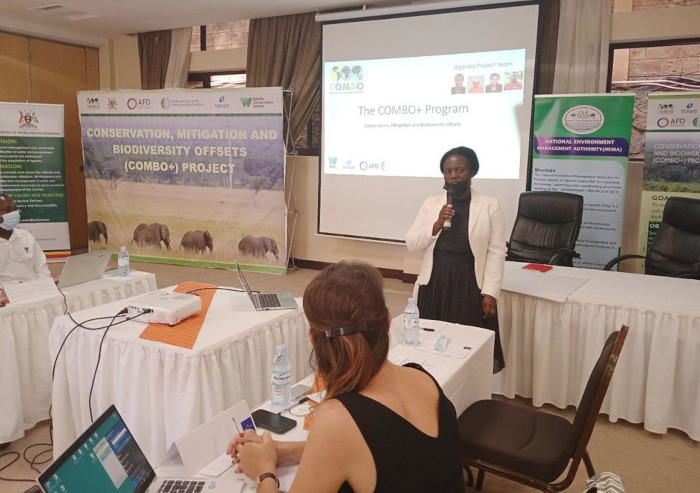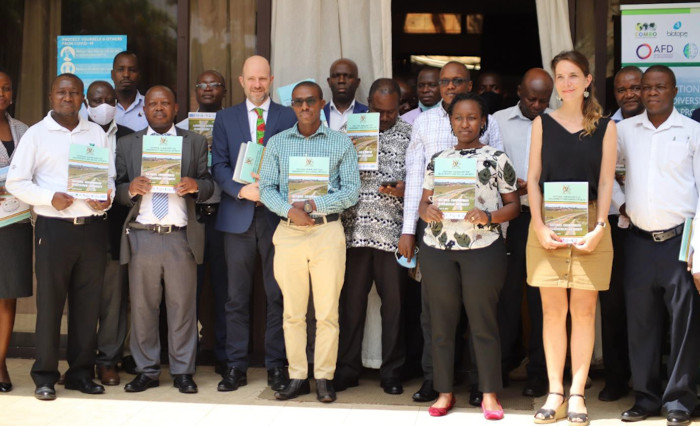
KAMPALA, Uganda: On June 14, 2022, the Conservation, Mitigation, and Biodiversity Offsets (COMBO+) Project, a four-year project implemented by the Wildlife Conservation Society (WCS) in partnership with Biotope and the government of Uganda institutions, was launched in Uganda. The second phase of the Conservation impact Mitigation and Biodiversity Offset (COMBO) project that commenced in 2021 will run until 2024. The project is funded by the Agence Française de Developpement (AFD) and the Fonds Français pour l’Environnement Mondial (FFEM) and aims at supporting the Government of Uganda to ensure economic development and conservation are balanced through the application of mitigation hierarchy processes — avoidance and minimization of development impacts in Key Biodiversity Areas, restoration of impacted sites, and finally offsetting their residual impacts so that biodiversity and people live in harmony.
The launch was attended by officials from the Ministry of Water and Environment, Ministry of Finance and Economic Development, Ministry of Energy and Mineral Development (MEMD), Petroleum Authority of Uganda (PAU), Uganda Investments Authority (UIA) Agence Française de Developpement (AFD), Uganda Wildlife Authority (UWA), National Environment Management Authority (NEMA), TotalEnergies EP Uganda, Makerere University, Ministry of Agriculture, Animal Industry and Fisheries(MAAIF), Uganda National Roads Authority (UNRA), Advocates Coalition on Development and Environment (ACODE), and other civil society organizations. Speaking at the launch, Wildlife Conservation Society Country Director, Dr. Simon Nampindo said, “Uganda is not giving developers a blank cheque to disturb sensitive and key Biodiversity Areas. Developers need to follow the mitigation hierarchy and they need to demonstrate clear, tangible, and measurable conservation outcomes that result in the compensation of adverse impacts on Biodiversity.”
At the same event, the National Environment Management Authority (NEMA), the principal agency charged with the responsibility of coordinating, monitoring, regulating, and supervising environmental management in Uganda launched the National Guidelines for Biodiversity and Social Offsets developed with support from the first phase of the COMBO project (2016-2019). These guidelines provide guidance to project developers, regulatory agencies, and other stakeholders on different aspects concerning biodiversity offsets to ensure the mitigation of residual impacts and the achievement of measurable conservation outcomes.

To demonstrate Uganda’s commitment to ensuring that guidelines for biodiversity and social offsets are complied with, David Ochanda, the Biodiversity Coordinator at Total Energies EP Uganda shared a best practice in applying the mitigation hierarchy in the Tilenga Biodiversity Program. The Net Gain Program aims at protecting and conserving biodiversity in Murchison Falls National Park (which is home to 109 mammals, 476 bird species, 14 reptiles, and 145 tree species), in close collaboration with Government agencies and international experts.
Mr Hatem Chakroun, the Country Director of AFD in Uganda informed participants that AFD and FFEM have been working with the Uganda Government since 2016 through the COMBO project that had facilitated the harmonization of Ugandan regulations with the World Bank’s International Finance Corporation (IFC) best practices and supported the government to align its mitigation policies with national biodiversity objectives, developed tools, and provided guidance to apply spatial analysis to avoid, minimize, restore and offset development impacts in Uganda. Mr. Chakroun congratulated WCS upon the launch of the COMBO+ project and its collaboration with NEMA to finalize the National Guidelines for Biodiversity and Social Offsets, which he noted were concrete proof of success and a useful tool. He noted that addressing challenges in applying the legal framework and guidelines regarding the mitigation hierarchy will “require political commitment, inter-ministerial coordination, continuous capacity-building efforts, and spatial planning so that the reconciliation of economic development and conservation can be achieved based on the application of the best available science, practices and anchored on a long-term vision.”
Uganda like all the other countries is seeking ways to balance the development and conservation of biodiversity and ecosystem services to enhance human wellbeing. In a speech read by Mr. Arnold Waiswa Ayazika, Director of Environmental Monitoring and Compliance at the National Environment Management Authority, the Minister of Water and Environment pointed out that “the National Guidelines for Biodiversity and Social Offsets have been developed as an additional tool to be integrated into the environment and social impact assessment (ESIA) process to mitigate the negative impacts of development projects on biodiversity and ensure a No net loss of biodiversity in Uganda. Biodiversity offsets are now a legal requirement (article 115 of the National Environment Act 2019) and therefore the development of these guidelines together with capacity building of relevant stakeholders is timely,” said Mr. Ayazika.